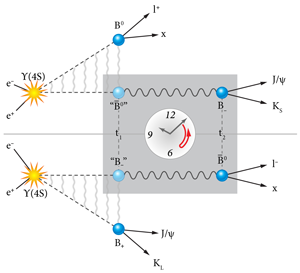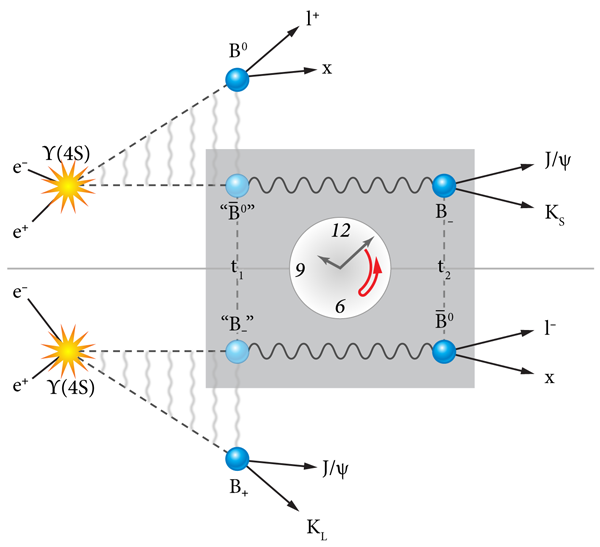Particle Decays Point to an Arrow of Time
Time moves irrevocably in one direction. Things get old, decay, and fall apart, but they rarely ever reassemble and grow young. But at the particle level, time’s arrow is not so clearly defined. Most collisions and other particle interactions look the same whether run forwards or backwards. Physicists have, however, identified a few reactions that appear to change when time is reversed, but the reasoning has assumed certain relations between fundamental symmetries of particle physics. The BaBar collaboration has now observed time-reversal violation directly and unambiguously in decays of B mesons. The measured asymmetry, reported in Physical Review Letters [1], is statistically significant and consistent with indirect observations.
In trying to understand the nature of particle interactions, observing the behavior of those interactions under different symmetry transformations has proven invaluable in formulating and verifying the fundamental theory. It is well known, and has been experimentally shown, that the strong and electromagnetic interactions are unchanged when viewed in a mirror world, in which particle positions are reflected ( →r to -→r ). In contrast, experiments in 1956 [2] demonstrated that the weak interaction is not invariant under such parity inversion (P). A decade later, researchers found evidence in K meson decays [3] that weak interactions may also violate a combination of parity inversion with charge conjugation (C), where particles are interchanged for antiparticles. Physicists continue to study CP violation, in part to explore whether it can explain the dominance of matter over antimatter in the universe. But a related symmetry, time inversion (T), has been more elusive. It involves running an experiment backwards ( t to -t) and converting initial states to final states. Weak interactions may violate time-reversal symmetry, but observing this directly with high enough precision proves difficult.
It is, however, possible to infer time-reversal violation (TRV) through observations of CP violation in K and B meson decays using the CPT theorem. The CPT theorem states that all local Lorentz invariant quantum field theories are invariant under the simultaneous operation of charge conjugation, parity reversal, and time reversal. Thus an experiment that measures a violation of CP might infer a corresponding lack of invariance under time reversal in order to maintain CPT invariance. Attempts to measure TRV without reference to CP violation have been controversial. Experiments at CPLEAR (measuring the difference in rates between K0 transitions to ˉK0 and ˉK0 transitions to K0 [4]) and at Fermilab (observing an asymmetry seen in the decay K0L→π+π-e+e- [5]) claim to detect TRV directly, but some researchers have doubted this interpretation because of complicating factors in the K meson decays.
Using a method suggested previously [6], Lees et al. of the BaBar collaboration have now observed an explicit time-reversal violation in the decay of B mesons [1]. The experiment, performed at the Stanford Linear Accelerator Center (SLAC) in California, takes advantage of entangled B0 and ˉB0 mesons in the Υ(4s) resonance produced in positron-electron ( e+e-) collisions at SLAC. This allows measurement of an asymmetry that can only come about through a T inversion, and not by a CP transformation.
Each of the entangled B0 and ˉB0 mesons resulting from the Υ(4s) can decay into either a CP eigenstate (e.g., J/ψKL, called B+ for CP even, and J/ψKs , called B- for CP odd), or a state that identifies the flavor of the meson (e.g., l-X for ˉB0 and l+X for B0, where l± is a lepton and X represents the other particles in the decay). To study T inversion, the experimenters selected events where one meson decayed into a flavor state and the other decayed into a CP eigenstate. The time between these two decays was measured, and the rate of decay of the second with respect to the first was determined. As an example, let’s consider events in which the first meson decays at time t1 into l+X for B0. Due to entanglement, the surviving meson is tagged as “ ˉB0” without being measured. At a later time t2 , this second meson decays into J/ψKs, implying a B- (see Fig. 1). The researchers compared these “ ˉB0” →B- events to the time-reversed pair: “ B-” →ˉB0, which are those events identified by both reversing the order of decays and exchanging initial and final states. In this example, the time-reversed events are the ones with a J/ψKL decay followed by a l-X decay.
One of the keys to identifying the various B meson combinations is the energetic, asymmetric e+e- collider of the PEP-II at SLAC. In the asymmetric collider, the beams are tuned to a center-of-mass energy of 10.58GeV, corresponding to the Υ(4s) mass. At that setting, 9GeV electrons collide with positrons at 3.1GeV, giving a boost to the resulting Υ(4s) and thus to its B and ˉB decay products. This extra momentum makes it possible for the BaBar detector to determine the species of each final state meson. The detector—built inside the flux return of a superconducting solenoid magnet—surrounds the e+e- collision point with cylindrical trackers followed by cylindrical calorimeters [7]. Those detectors both track the outgoing trajectories and identify the particle species of the collision products, with reconstruction of that information yielding the identities of the B mesons. The flavor identity of neutral B mesons was made on the basis of the charges of prompt leptons, kaons, pions from D* mesons, and high-momentum charged particles, while the B- states were reconstructed from several CP-odd states in addition to the J/ψKs mode. K0L mesons passed through the trackers undetected, so J/ψK0L states were reconstructed with information from the decay product appearances in the outer detectors and the information from the other particles in the B decay.
After detecting and identifying the mesons, the experimenters determined the proper time difference between the decay of the two B states by determining the energy of each meson and measuring the separation of the two meson decay vertices along the e+e- beam axis. When time-reversed pairs were compared, the BaBar collaboration found discrepancies in the decay rates. The asymmetry, which could only come from a T transformation and not a CP violation, was significant, being fourteen standard deviations away from time invariance. Thus the long wait for an unequivocal time-reversal violation in particle physics is finally over.
References
- J. P. Lees et al. (The BABAR Collaboration), “Observation of Time-Reversal Violation in the B0 Meson System,” Phys. Rev. Lett. 109, 211801 (2012)
- C. S. Wu,E. Ambler, R. W. Hayward, D. D. Hoppes, and R. P. Hudson, “Experimental Test of Parity Conservation in Beta Decay,” Phys. Rev. 105, 1413 (1957)
- J. H. Christenson, J. W. Cronin, V. L. Fitch, and R. Turlay, “Evidence for the 2pi Decay of the K2 0 Meson,” Phys. Rev. Lett. 13, 138 (1964)
- A. Angelopoulus et al. (CPLEAR Collaboration), “First Direct Observation of Time-Reversal Non-invariance in the Neutral-Kaon System,” Phys. Lett. B 444, 43 (1998)
- E. Abouziad et al., “Precise Measurements of Direct CP Violation, CPT Symmetry, and Other Parameters in the Neutral Kaon System,” Phys. Rev. D 83, 092001 (2011)
- J. Bernabeu, F. Martinez-Vidal, and P. Villanueva-Perez, “Time Reversal Violation from the Entangled B0B0 System,” J. High Energy Phys. 1208, 064 (2012)
- B. Aubert et al., “The BABAR Detector,” Nucl. Instrum. Methods Phys. Res. Sect. A 479, 1 (2002)





